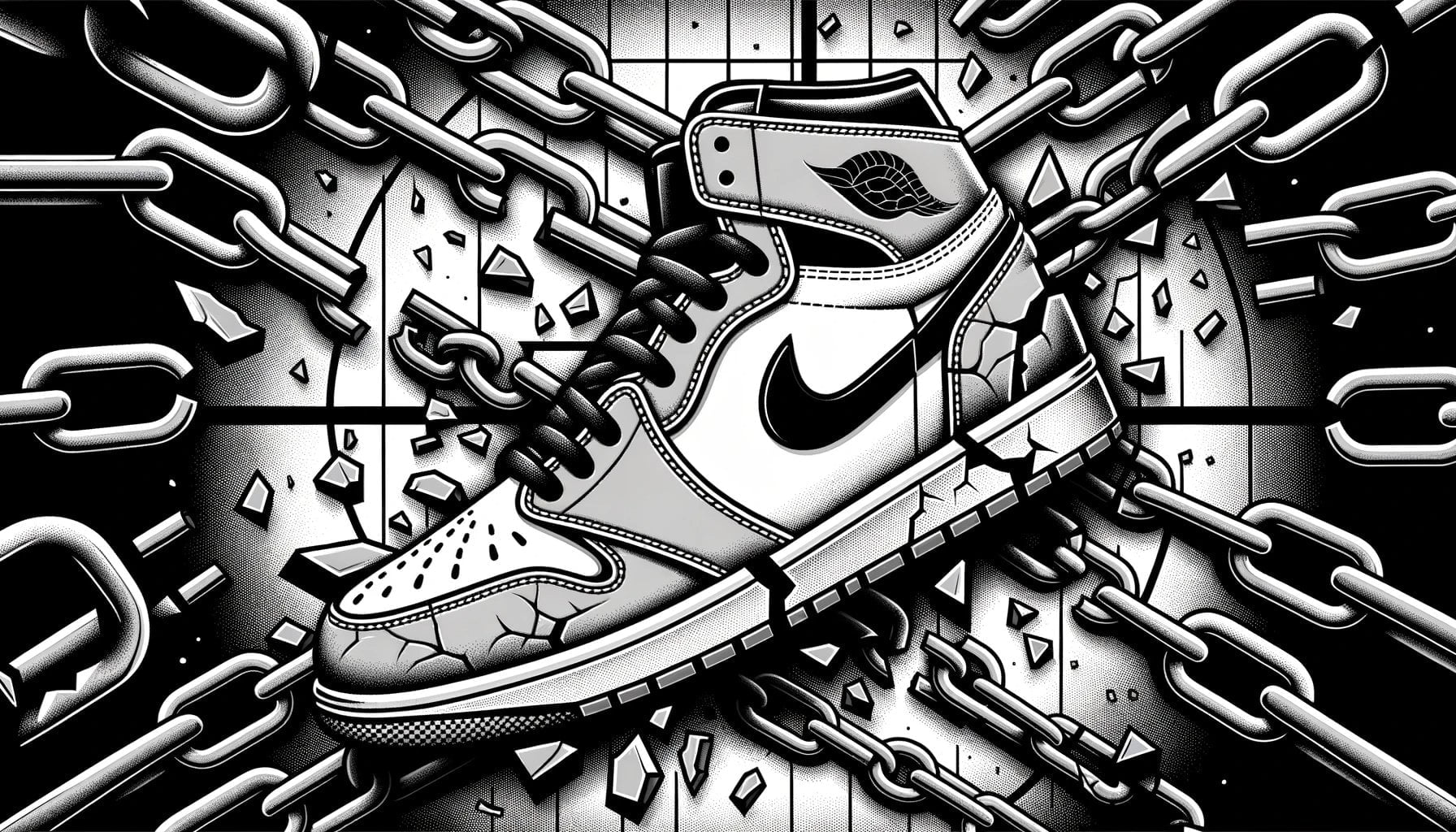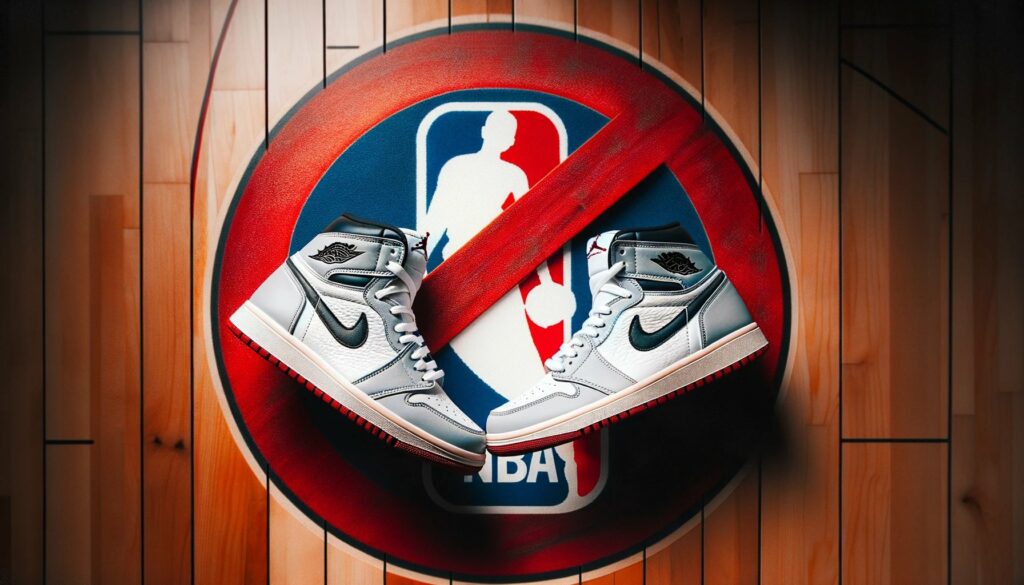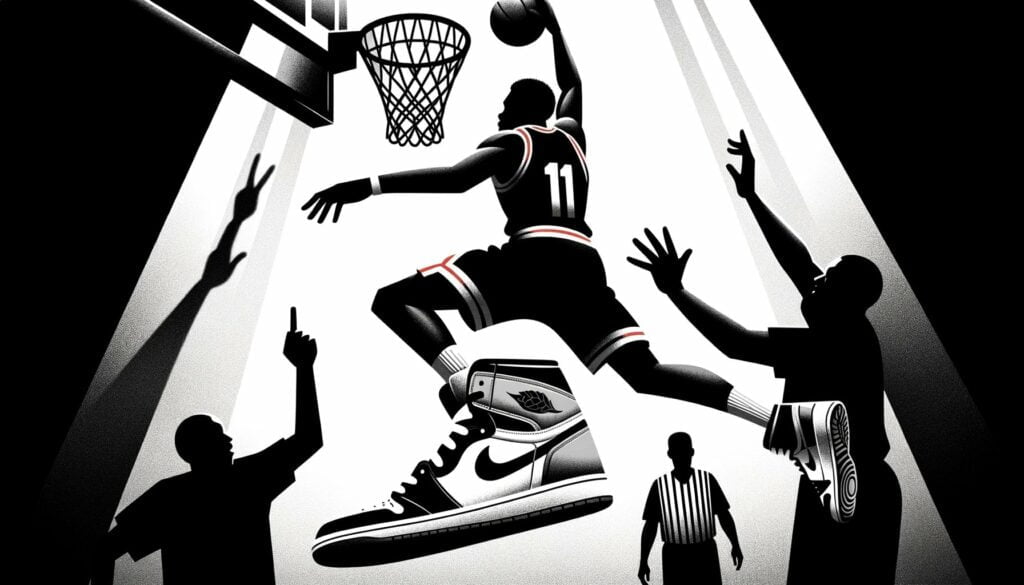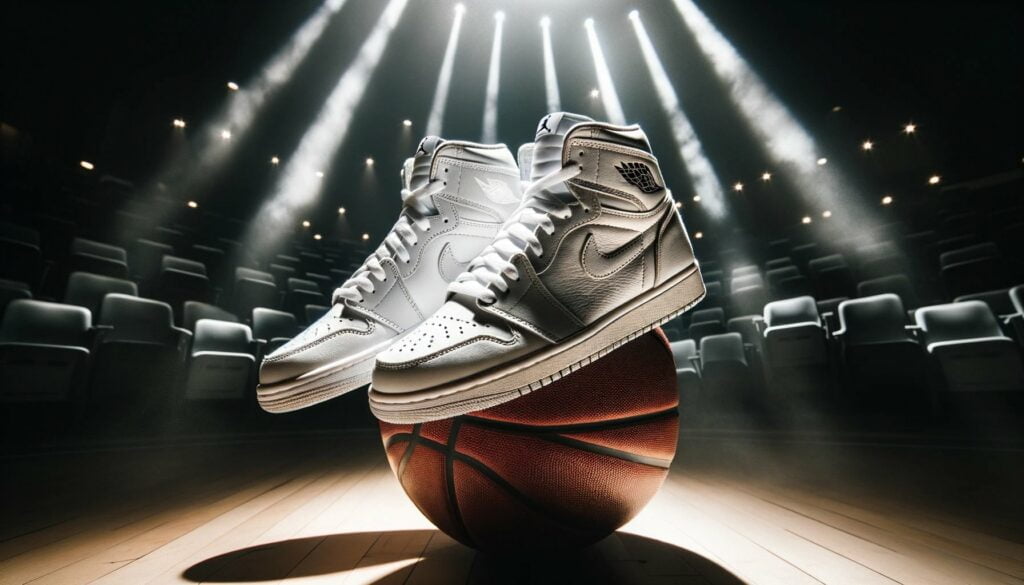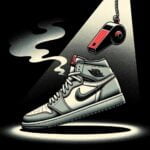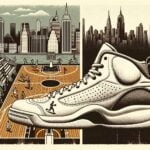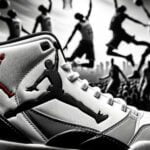The Banned Jordan 1: Unraveling the NBA’s Controversial Decision – In the enthralling world of basketball, few tales are as captivating as the banned Jordan 1’s mysterious journey. Curiosity and intrigue surround the question: Why was Jordan 1 banned from the NBA? As an experienced sports journalist with an insatiable passion for basketball history, I’m here to provide an illuminating exploration into the fascinating circumstances that led to the iconic sneaker’s prohibition. Drawing on my extensive expertise in sports reporting and unparalleled research skills, this in-depth analysis aims to bridge the gap between sports enthusiasts and the captivating history behind the NBA’s controversial decision.
Why was Jordan 1 banned from NBA?
Throughout the history of the NBA, there have been countless moments that have captured the attention and curiosity of sports enthusiasts. One such moment revolves around the iconic Air Jordan 1, a shoe that not only revolutionized the sneaker industry but also found itself at the center of controversy within the basketball world. In this article, we dive into the intriguing story behind the ban on the Jordan 1 and shed light on the reasons that led to this historic decision.
The Background Story
It all started on October 18, 1984, when a young rookie named Michael Jordan stepped onto the court wearing a pair of black and red Air Jordan 1’s for a preseason game against the New York Knicks. Little did he know that this seemingly innocent choice of footwear would pave the way for a significant shift in the fashion dynamics of the NBA.
Violating the League’s Uniform Policy
At that time, the NBA had a strict uniform policy in place, which required players to wear shoes that were predominantly white. The league believed that this rule would promote a sense of uniformity and professionalism among the players, ensuring that the focus remained solely on the game. However, Jordan’s bold choice of black and red sneakers directly violated this policy, catching the attention of both fans and league officials.
The $5,000 Fine and the “51% Rule”
In response to his violation of the uniform policy, Michael Jordan was fined $5,000 by the NBA. This penalty was not only a financial setback but also a significant statement, showcasing the league’s commitment to enforcing their regulations. The banned Jordan 1 became a symbol of rebellion and individuality, as Jordan continued to wear them despite the consequences.
Behind the scenes, the ban on Air Jordan 1’s was a result of the league’s “51% rule.” This rule required basketball sneakers to be mostly white and in accordance with the team’s jerseys. The thinking behind this rule was to maintain the visual harmony between the players’ shoes and their uniforms. However, with the introduction of the vibrant and eye-catching Air Jordan 1’s, this rule seemed outdated and restrictive to many.
The Changing Tide
As time went on, the ban on the Air Jordan 1’s was eventually lifted, marking a significant turning point in the relationship between fashion, sports, and the NBA. The league realized that they had to embrace the individuality and creativity of the players, as fashion became an integral part of basketball culture. The forbidden status of the Jordan 1’s only fueled the demand for these sneakers, making them an iconic symbol of rebellion and style.
The Legacy of the Banned Jordan 1
The Air Jordan 1 ‘Banned’ model has become a fascinating chapter in basketball history, capturing the imagination of sneaker enthusiasts and sports fans alike. It serves as a testament to the power of self-expression and the impact that fashion can have within the confines of professional sports. Today, the Jordan 1’s can be worn by anyone on the streets or on the court without any restrictions, showcasing the evolution of the NBA’s acceptance of individualism and unique personal style.
In conclusion, the ban on the Jordan 1 in the NBA was a result of violating the league’s uniform policy, specifically the “51% rule” that required predominantly white shoes. This decision sparked controversy and defiance, ultimately leading to a shift in the NBA’s approach to fashion and individuality. The Jordan 1’s journey from being banned to becoming an iconic symbol of self-expression is a testament to the ever-evolving nature of sports and culture.
The era of basketball has gifted us with many iconic moments and jaw-dropping plays. And what better way to relive those moments than by stepping into the first basketball shoes ever made? Experience the thrill of the game firsthand with a pair of our first basketball shoes. Crafted with utmost precision and attention to detail, these shoes will transport you back to the golden age of basketball. Lace them up and channel your inner basketball legend as you dominate the court. Get your hands on these timeless classics today by clicking here.
Competition Between Shoe Brands and Potential Influence on the Ban
It’s no secret that competition drives innovation, and in the world of sports, this competition extends beyond the players on the court. Shoe brands have long been vying for the attention and endorsement of top athletes, and their battle for market dominance often spills over into the realm of professional sports leagues. The ban of the iconic Jordan 1 by the NBA in 1985 serves as a prime example of the complex dynamics between shoe brands and their potential influence on league regulations.
The Clash of Brands
In the early 1980s, Nike was a relatively new player in the athletic footwear industry, while established brands like Adidas and Converse had already solidified their positions. Nike recognized the untapped potential of collaborating with up-and-coming athletes who possessed both talent and star power. Enter Michael Jordan, a young and electrifying basketball player who was on his way to becoming a global icon.
Michael Jordan and Nike: A Match Made in Sneaker Heaven
Michael Jordan’s decision to sign with Nike was a groundbreaking move that catapulted both the player and the brand into unprecedented heights of fame and profitability. Nike’s ability to capitalize on Jordan’s success and create a dynamic and innovative footwear line led to the birth of Air Jordans, a collection that would forever change the sneaker landscape.
The Launch of the Banned Jordan 1
With the stage set for their collaboration, Nike and Michael Jordan unveiled the first-ever Air Jordan sneakers, the Jordan 1, in 1985. However, little did they know that the NBA’s strict dress code would come into play and potentially jeopardize the future of this groundbreaking shoe.
League Regulations and the Ban
The NBA, known for its adherence to tradition and uniformity, had a dress code in place that required players to wear predominantly white shoes. The bold and unconventional design of the Jordan 1, with its black and red color scheme, flew in the face of the league’s regulations. The NBA saw the Air Jordans as too distinctive and potentially distracting to fans. This clashed with their desire to uphold a sense of uniformity and conformity among players.
The Fine and the Marketing Strategy
With each violation of the dress code, Michael Jordan was fined $5,000. Rather than viewing this as a setback, Nike recognized the ban as a unique marketing opportunity. They saw the potential to create a sense of exclusivity and desirability around the Air Jordans, positioning them as shoes that were “too cool” for the NBA. Nike embraced the ban and paid the fines on Jordan’s behalf, turning a perceived restriction into a captivating narrative that captured the imaginations of sneaker enthusiasts worldwide.
The Popularity and Legacy of the Banned Jordan 1
The ban on the Jordan 1 only served to heighten their desirability. Sneaker enthusiasts and collectors yearned to own a pair of shoes that were deemed too revolutionary for the NBA. The Air Jordans became a cultural phenomenon that transcended the realm of basketball and infiltrated popular culture, fashion, and sports marketing. The ban increased the mystique surrounding the shoes, elevating Jordan’s status as an icon and solidifying the Air Jordan brand as a symbol of power, style, and exclusivity.
Conclusion
The ban of the Jordan 1 by the NBA was a fascinating chapter in the history of basketball and sneaker culture. It showcased the immense competition between shoe brands and their potential influence on league regulations. Nike’s collaboration with Michael Jordan and the subsequent ban propelled the Air Jordans to new heights of popularity, forever cementing their place in the annals of sports, fashion, and popular culture. The legacy of the banned Jordan 1 resonates to this day, a testament to the enduring power of innovative design, marketing strategy, and the indomitable spirit of competition.
The Long-Lasting Impact and Legacy of the Banned Jordan 1
In the rich tapestry of basketball history, few moments have left a lasting impact quite like the banning of the Jordan 1 from the NBA. The story behind this iconic sneaker and its controversial journey has captivated sports enthusiasts for decades. As a seasoned sports journalist with a keen interest in basketball history, I have delved deep into the intriguing tale behind the ban, uncovering the factors that led to this extraordinary event.
The Rise of the Banned Sneakers
The Air Jordan 1 ‘Banned’ refers to a pair of sneakers worn by Michael Jordan during his rookie season in 1984. Although these sneakers were not actually the Air Jordan 1, they were the Nike Air Ship, featuring a silhouette similar to the renowned sneaker. The NBA banned the Nike Air Ship due to its color scheme, which violated the league’s strict uniform code.
At this point, a young Michael Jordan had already begun to make a name for himself as a rising star in the league. Despite the ban, he boldly continued to wear the sneakers during games, fully aware of the consequences. For each game he played in the banned sneakers, Jordan faced fines from the NBA. However, Nike stepped up and paid the fines, seizing this unexpected turn of events as a marketing opportunity.
Turning Controversy into Success
Nike’s decision to embrace the ban as a marketing strategy proved to be a stroke of genius. By promoting the sneakers as “banned” by the NBA, they sparked curiosity and controversy among basketball fans and sneaker enthusiasts alike. This innovative approach created a sense of exclusivity and desirability around the Air Jordans, catapulting them into the spotlight.
The ban inadvertently became the catalyst for the rapid rise of the Air Jordan 1. It transformed a simple sneaker into a cultural icon, transcending its original purpose as a basketball shoe. The bold design and rebellious spirit embodied by the banned Jordan 1 resonated with a generation seeking individuality and self-expression.
Cementing a Legacy
Following the ban, the Air Jordan 1 was eventually released in its original black and red colorway, aptly known as the “Bred” or “Banned” colorway. This release further solidified the connection between the sneakers and their controversial history, amplifying their allure. The Air Jordan 1’s status as a highly sought-after sneaker paved the way for subsequent releases in various colorways and collaborations, cementing its enduring legacy in sneaker culture.
The story of the NBA ban on the Air Jordan 1 is a testament to the intricate dynamics between athletes, brands, and league regulations. It showcases the power of marketing and how even controversial decisions can fuel the success of a product. The banned Jordan 1 not only symbolizes innovative design and shrewd marketing strategy but also represents the intense competition between shoe brands and their potential influence on league rules.
Unraveling the Controversial Decision
Reflecting on the long-lasting impact and legacy of the banned Jordan 1, one can’t help but wonder: Why did the NBA impose such a ban in the first place? To comprehend the rationale behind this decision, it’s crucial to understand the context of the league’s strict dress code and the potential impact of distinctive sneakers on the fan experience.
The NBA had implemented a dress code that required players to predominantly wear white shoes, aligning with a traditional aesthetic. The Air Jordans, with their bold design and non-conforming style, were seen as potentially distracting to fans and deviating from the desired uniformity on the court. This clash of creative expression and regulatory conformity prompted the ban.
While the NBA’s decision was met with controversy, it inadvertently propelled the Air Jordan 1 to unprecedented heights. The ban brought attention to the sneaker, elevating its desirability and allure. It became a symbol of rebellion and individuality, resonating with an entire generation. The legacy of the banned Jordan 1 endures to this day, encapsulating the spirit of innovation, marketing prowess, and the ever-evolving landscape of fashion and culture.
In conclusion, the banned Jordan 1 stands as a testament to the power of controversy and the ability of a single sneaker to transcend the world of sports. Its long-lasting impact and legacy have left an indelible mark, etching a tale of triumph against adversity and forever connecting the realms of basketball and fashion. The ban itself may have been an obstacle for Michael Jordan, but it ultimately became a stepping stone to greatness and a symbol of timeless style and individuality.
FAQ
Q: Why was the Jordan 1 banned from the NBA?
A: The Jordan 1 was banned from the NBA because it did not meet the league’s dress code requirements. The league’s dress code at the time required shoes to be predominantly white, but the Air Jordan sneakers were all-black and red. As a result, Michael Jordan was fined $5,000 every time he wore the banned shoes on the court.
Q: What was the reasoning behind the NBA’s decision to ban the Jordan 1?
A: The NBA wanted to enforce its rules and regulations, and they found the Air Jordans to be too distinctive and a distraction for fans. The league wanted players to wear shoes that adhered to the dress code, and the bold design of the Air Jordan 1 went against those regulations.
Q: How did Nike respond to the NBA banning the Air Jordans?
A: Nike paid the fines associated with the banned shoes and used the ban as a marketing strategy. This strategy made the Air Jordan sneakers more desirable and exclusive, ultimately leading to an increase in the brand’s popularity and creating a sense of exclusivity around the sneakers.
Q: What impact did the ban have on Michael Jordan and the Air Jordan brand?
A: The ban on the Air Jordan 1 expanded Michael Jordan’s influence beyond basketball and into sports marketing, athlete endorsement deals, fashion, and popular culture. It helped establish the Air Jordan brand as a symbol of style and dominance, and it added to the legacy of the iconic Air Jordan 1.
Q: Are Air Jordan sneakers still banned in the NBA?
A: No, Air Jordan sneakers are no longer banned in the NBA. Over the years, the NBA has evolved its dress code rules, allowing players more freedom in their choice of footwear. Air Jordan sneakers are now commonly worn by NBA players and have become a staple in basketball culture.
- Star Ring Trends: Etsy vs Amazon - March 28, 2025
- Boost Pollinator Habitats: Baby Blue Eyes Sustainable Farming Guide - March 28, 2025
- Protect Big Black Bears: Effective Conservation Strategies - March 28, 2025
